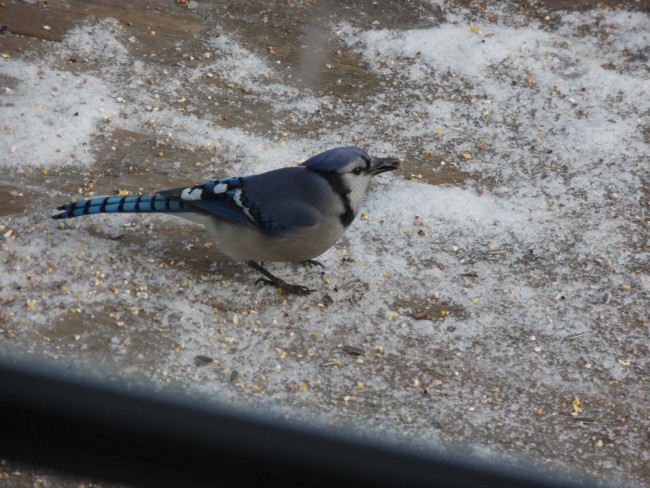

Photo Credit / Briana Magistro
By Briana Magistro
SC Staff Writer
A common sight in the eastern and central United States, the blue jay flies into this semester’s first “Animal of the Issue.” The blue jay is commonly found in coniferous, deciduous, and suburban areas of the eastern United States.
A midsized songbird, the blue jay is not particularly timid. It has been known to scare away smaller birds, especially feeders, by swooping down and screeching. They are not good at sharing, and will typically not even eat with others of their own species.
Blue jays can make many calls, including imitations of birds of prey, like hawks, in order to scare off other birds. However, once acclimated to a local mixed flock, some blue jays will tolerate other songbirds, and they may even act as guards, giving warning calls if a predator is nearby.
Blue jays have an average wingspan of over a foot wide, but they are not actually fast fliers. These jays fly in such a way that does not allow for optimal speed. Therefore, they can be picked out of the open sky by quick and agile predators, like owls. This is why they typically live in areas with a lot of trees or hiding places.
The blue jay is extremely distinguishable, as it has a bright blue plumage on its back and pointed head. It also has a white belly and various black markings.
Contrary to common belief, the blue jay’s color does not come from pigment is its feathers. The feathers are specifically refractive to give off blue color in white light. This means that the molecular structure of the feathers enables only blue color to be refracted in sunlight.
Other birds, such as peacocks, also have feathers that refract light in such a way. This is why some birds can have such brilliant and intricate color patterns. If the feathers are damaged, they will not show color since the specific structures that refract light are broken.
The diet of the blue jay includes nuts, seeds, fruits, grains, and insects. Unlike other songbirds, blue jays don’t have a preference for where their food comes from, whether it is a berry hanging from a tree or a nut that fell to the ground. They have also been known to carry off nuts to their nests to eat later. Their beaks are hard and strong, and can easily break apart the shells of most nuts.
Blue jay nests are cupshaped and are usually made in trees or big bushes. Like with eating, blue jays are not particular about where they choose to nest and will sometimes even make nests in mailboxes or the homes of other birds. Both mates take part in caring for the nest.
Blue jays can lay between three and seven eggs. The baby birds are able to fly in under a month. Unlike other birds, blue jay babies will stay with their families until fall, when food starts to become scarce.
In the wild, blue jays have been recorded to live longer than 15 years, and have been known to live longer than 20 years in captivity. Although the natural lifespan of the blue jay is long, the birds rarely live past 10 years. This is due to collisions with cars and other urban disturbances.
Mosquitoes, a food source of blue jays and other birds, carry the West Nile Virus, a generally fatal disease that can be contracted by birds after digesting infected food.
To attract blue jays to your home, it is recommended that you use wild birdseeds that contain large seeds, like sunflower seeds or peanuts. Suet, a hard block feed used for woodpeckers and large songbirds, also attracts blue jays. You will know when a blue jay is visiting your deck when you hear its long screech!
Email Briana at:
bmagistro@live.esu.edu
